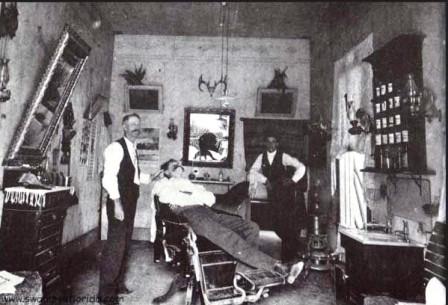Richfield Dentist
Does anyone have any memories of going to a dentist in Richfield? Dr. Sabo from Slinger practiced in Richfield in a building on the east side of Hwy 175. A Richfield resident remembers Dr. Felbe located 2 building to the south of the former Methodist church on Hwy 175. Let’s learn about going to the dentist long ago.
Chew on This: Facing FEAR in the 1800s
For many people, the answer to the question, “What do you FEAR?” (following speaking in public), is: the DENTIST. Have you ever wondered how our great-great-great grandparents took care of their teeth? Let’s visit dental hygiene circa mid-to-late 1800s.
The progression of years through the 1800s brought major breakthroughs in dentistry. According to dentalcenter-in.com, these changes continued well into the 1900s. During this time, Penicillin was developed, composite fillings were created, and the first fully reclining dental chair was invented. Today, instead of visiting a barber-surgeon, and enduring dental care with crude tools and no anesthesia, we can easily pick up the phone and find a dentist who employs all of today’s modern conveniences.
Why the FEAR? Here are some possible reasons that our ancestors FEARed anything having to do with teeth issues.
 Fear #1: The ‘dentist’ was a barber. A person needed no training to pull out a troublesome tooth. In addition to cutting hair, barbers also performed surgery and would pull out teeth. According to www.history.com, that’s why barber shops have red and white striped poles outside their doors–to represent blood and bandages.
Fear #1: The ‘dentist’ was a barber. A person needed no training to pull out a troublesome tooth. In addition to cutting hair, barbers also performed surgery and would pull out teeth. According to www.history.com, that’s why barber shops have red and white striped poles outside their doors–to represent blood and bandages.
Fear #2: Pain. Dental issues were handled without the benefit of pain relief. In 1846, Massachusetts dentist William Morton was the first to use anesthesia prior to tooth extraction. On October 16, 1846, Massachusetts General Hospital, dubbed "ether day," hosted the first public demonstration of the use of ether as a surgical anesthetic. It was a welcomed success! Thankfully, by the time Lincoln was president, sedation methods were becoming more common.
 Fear #3: The Drill. Yes, drills were used in the mid-1800s. In 1848, Waldo Hanchett patented the dental chair. Decades later, in 1875, George Green invented the first electric foot
Fear #3: The Drill. Yes, drills were used in the mid-1800s. In 1848, Waldo Hanchett patented the dental chair. Decades later, in 1875, George Green invented the first electric foot  pedal-operated pneumatic drill.
pedal-operated pneumatic drill.
Fear #4: Lack of daily care meant ...infection, tooth loss, bad odors! Most Americans did not brush their teeth until Army soldiers brought their enforced habits of tooth brushing back home after World Warr II. Twigs or rags were often used to scrape or wipe teeth.
Those who did practice some kind of dental hygiene may have had a difficult time procuring a toothbrush. Mass production of toothbrushes began in the U.S. around 1885. American innovator H.N. Wadsworth held the first patent  for a toothbrush in 1857 using ‘natural’ bristles from pigs, but it wasn’t until the 1930s that nylon bristles made toothbrushes look more like the ones seen today. Interestingly, many today believe that natural brushes are less abrasive than those made with nylon filaments.
for a toothbrush in 1857 using ‘natural’ bristles from pigs, but it wasn’t until the 1930s that nylon bristles made toothbrushes look more like the ones seen today. Interestingly, many today believe that natural brushes are less abrasive than those made with nylon filaments.
Toothpaste? People would use chalk and brick dust to get rid of any muck; sometimes they’d mix salt with bicarbonate of soda for a foamy finish. Early versions of toothpaste almost always contained soap. In the 1880s, ‘tube toothpaste’ became mass-produced in factories and sold across the U.S. After first marketing its toothpaste in jars, Colgate began using the ‘tubes’ in the 1890s.
Eventually, the barber’s dental services were taken over by graduates of dental colleges. The first in the United States, established in 1840, was called the Baltimore College of Dental Surgery. It took some time for a dental college to come to Wisconsin, but it did. The Wisconsin College of Physicians and Surgeons, which opened in 1893, added a dental department in 1899. It merged with Marquette University in 1913.
Feeling less FEARful about dentists? Be glad it’s the 2000s and not the 1800s!
This article was written by Susan Brushafer, an RHS volunteer. Join the Richfield Historical Society if you enjoy fully researched articles. Three times per year, members receive a Newsletter filled with articles and Society news. Click on the Get Involved menu item above and select Become a Member.
Photos: Dentist Office; Waldo Hanchett Dental Chair; George Green’s pneumatic drill; Wadsworth's Toothbrush
Enjoy our other stories

